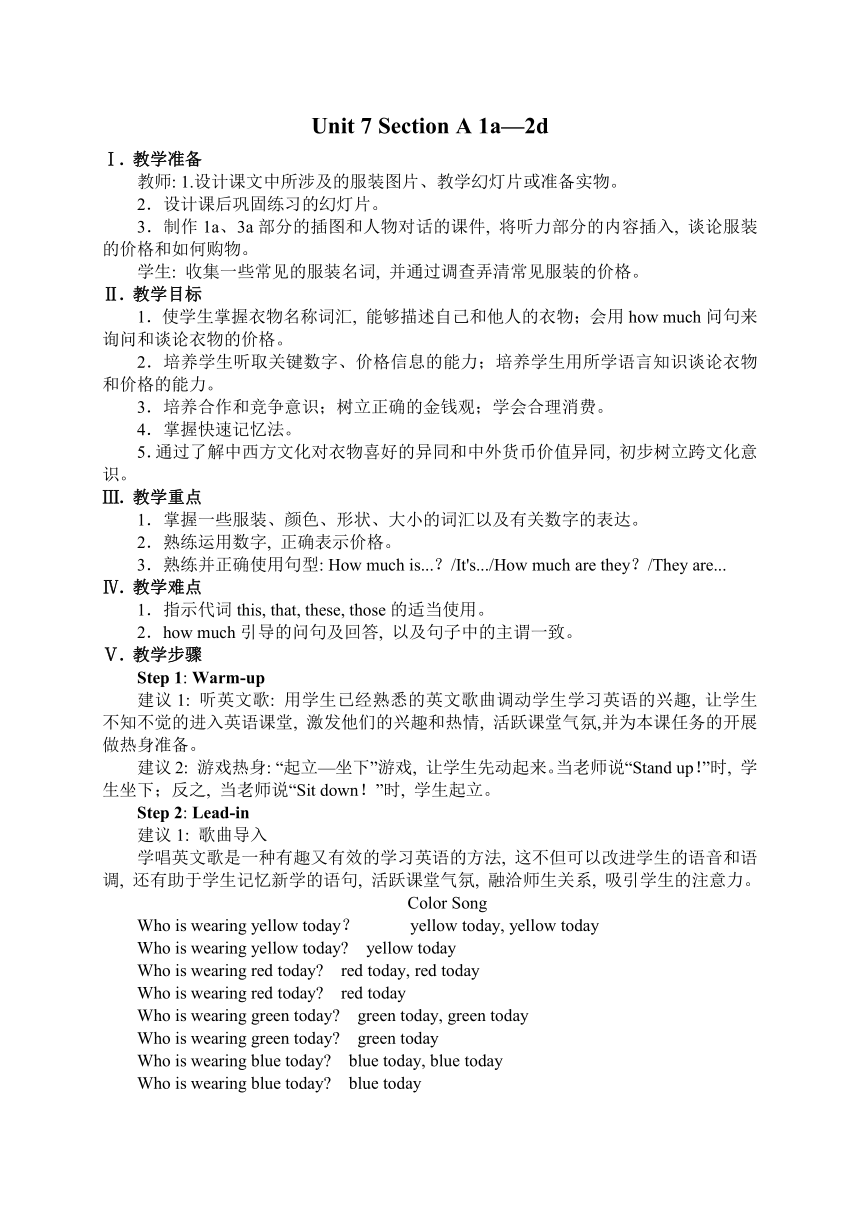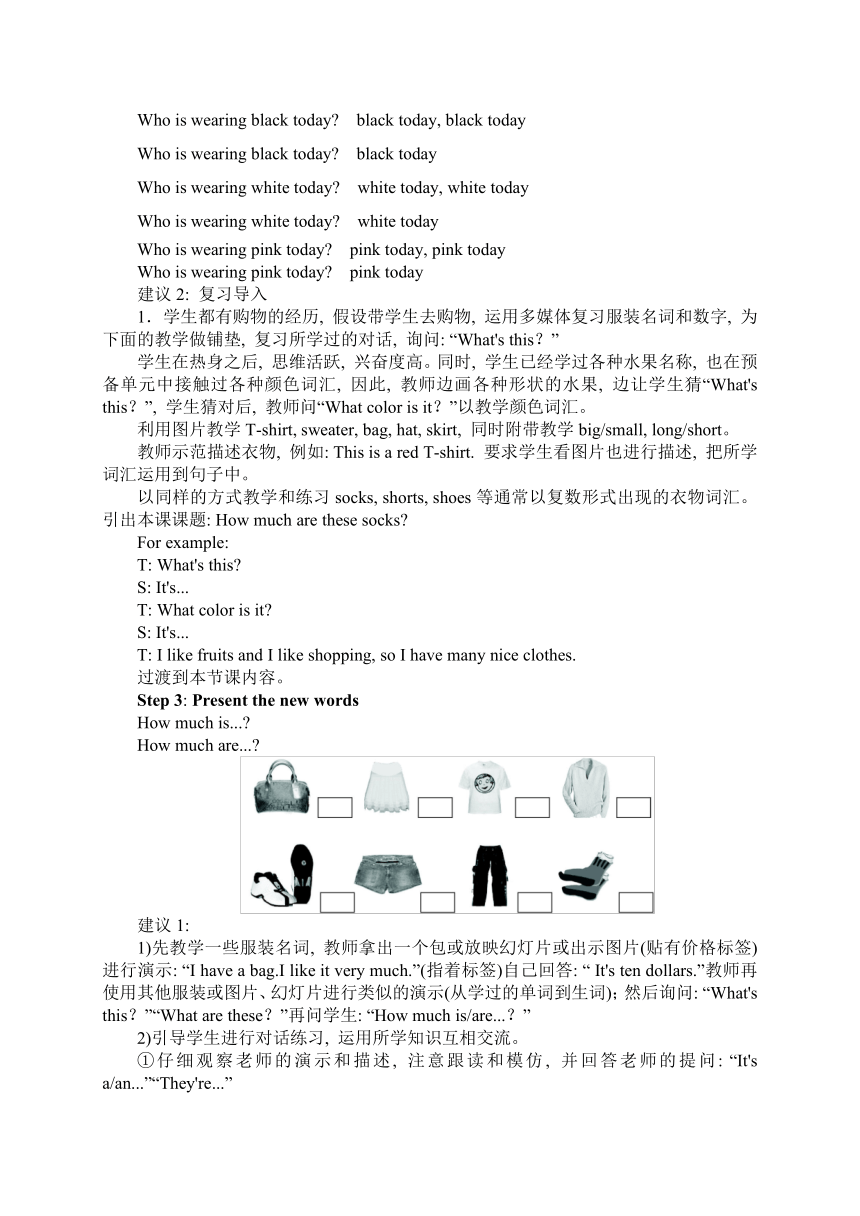Unit 7 How much are these socks? Section A 1a-2d(教案)
文档属性
| 名称 | Unit 7 How much are these socks? Section A 1a-2d(教案) |  | |
| 格式 | doc | ||
| 文件大小 | 1.3MB | ||
| 资源类型 | 教案 | ||
| 版本资源 | 人教新目标(Go for it)版 | ||
| 科目 | 英语 | ||
| 更新时间 | 2021-10-07 09:29:06 | ||
图片预览


文档简介
Unit
7
Section
A
1a—2d
Ⅰ.
教学准备
教师:
1.设计课文中所涉及的服装图片、教学幻灯片或准备实物。
2.设计课后巩固练习的幻灯片。
3.制作1a、3a部分的插图和人物对话的课件,
将听力部分的内容插入,
谈论服装的价格和如何购物。
学生:
收集一些常见的服装名词,
并通过调查弄清常见服装的价格。
Ⅱ.
教学目标
1.使学生掌握衣物名称词汇,
能够描述自己和他人的衣物;会用how
much问句来询问和谈论衣物的价格。
2.培养学生听取关键数字、价格信息的能力;培养学生用所学语言知识谈论衣物和价格的能力。
3.培养合作和竞争意识;树立正确的金钱观;学会合理消费。
4.掌握快速记忆法。
5.通过了解中西方文化对衣物喜好的异同和中外货币价值异同,
初步树立跨文化意识。
Ⅲ.
教学重点
1.掌握一些服装、颜色、形状、大小的词汇以及有关数字的表达。
2.熟练运用数字,
正确表示价格。
3.熟练并正确使用句型:
How
much
is...?/It's.../How
much
are
they?/They
are...
Ⅳ.
教学难点
1.指示代词this,
that,
these,
those的适当使用。
2.how
much引导的问句及回答,
以及句子中的主谓一致。
Ⅴ.
教学步骤
Step
1:
Warm up
建议1:
听英文歌:
用学生已经熟悉的英文歌曲调动学生学习英语的兴趣,
让学生不知不觉的进入英语课堂,
激发他们的兴趣和热情,
活跃课堂气氛,并为本课任务的开展做热身准备。
建议2:
游戏热身:
“起立—坐下”游戏,
让学生先动起来。当老师说“Stand
up!”时,
学生坐下;反之,
当老师说“Sit
down!”时,
学生起立。
Step
2:
Lead in
建议1:
歌曲导入
学唱英文歌是一种有趣又有效的学习英语的方法,
这不但可以改进学生的语音和语调,
还有助于学生记忆新学的语句,
活跃课堂气氛,
融洽师生关系,
吸引学生的注意力。
Color
Song
Who
is
wearing
yellow
today? yellow
today,
yellow
today
Who
is
wearing
yellow
today
yellow
today
Who
is
wearing
red
today
red
today,
red
today
Who
is
wearing
red
today
red
today
Who
is
wearing
green
today
green
today,
green
today
Who
is
wearing
green
today
green
today
Who
is
wearing
blue
today
blue
today,
blue
today
Who
is
wearing
blue
today
blue
today
Who
is
wearing
black
today
black
today,
black
today
Who
is
wearing
black
today
black
today
Who
is
wearing
white
today
white
today,
white
today
Who
is
wearing
white
today
white
today
Who
is
wearing
pink
today
pink
today,
pink
today
Who
is
wearing
pink
today
pink
today
建议2:
复习导入
1.学生都有购物的经历,
假设带学生去购物,
运用多媒体复习服装名词和数字,
为下面的教学做铺垫,
复习所学过的对话,
询问:
“What's
this?”
学生在热身之后,
思维活跃,
兴奋度高。同时,
学生已经学过各种水果名称,
也在预备单元中接触过各种颜色词汇,
因此,
教师边画各种形状的水果,
边让学生猜“What's
this?”,
学生猜对后,
教师问“What
color
is
it?”以教学颜色词汇。
利用图片教学T shirt,
sweater,
bag,
hat,
skirt,
同时附带教学big/small,
long/short。
教师示范描述衣物,
例如:
This
is
a
red
T shirt.
要求学生看图片也进行描述,
把所学词汇运用到句子中。
以同样的方式教学和练习socks,
shorts,
shoes等通常以复数形式出现的衣物词汇。引出本课课题:
How
much
are
these
socks
For
example:
T:
What's
this
S:
It's...
T:
What
color
is
it
S:
It's...
T:
I
like
fruits
and
I
like
shopping,
so
I
have
many
nice
clothes.
过渡到本节课内容。
Step
3:
Present
the
new
words
How
much
is...
How
much
are...
建议1:
1)先教学一些服装名词,
教师拿出一个包或放映幻灯片或出示图片(贴有价格标签)进行演示:
“I
have
a
bag.I
like
it
very
much.”(指着标签)自己回答:
“
It's
ten
dollars.”教师再使用其他服装或图片、幻灯片进行类似的演示(从学过的单词到生词);然后询问:
“What's
this?”“What
are
these?”再问学生:
“How
much
is/are...?”
2)引导学生进行对话练习,
运用所学知识互相交流。
①仔细观察老师的演示和描述,
注意跟读和模仿,
并回答老师的提问:
“It's
a/an...”“They're...”
②进行小组对话练习。
建议2:
在教学生一些衣服名称时,
设计英语购物活动。在这个活动中,
在教室里布置一个小“超市”,
里面放置各种衣服,
穿上附近超市导购员的工作服询问学生:
“Can
I
help
you?”学生从教师的动作中显然能了解这句话的含义,
他们回答:
“我要一件T恤,
”接着教师用英语重复他们的话“I
want
a
T shirt.”。通过几次购买,
学生由倾听产生了说的愿望,
最后开口用英语和教师边游戏边交流“Can
I
help
you?”(你要买什么?),
“I
want
a
T shirt.”(我要一件T恤衫),
“Here
you
are.”(给你),
“
Thank
you.”(谢谢)。可经常让学生玩这个游戏,
轮流扮演售货员,
其他学生排队购买衣物,
整个游戏活动由于涉及到学生熟悉的情景,
使学生在看看、听听、说说、玩玩中轻松自然地掌握几种常见衣物的英语名称和简单的购物用语。
建议3:
Show
students
some
colors.
T:
These
are
different
colors.
What
colors
are
they
S:
They
are
black,
white,
red,
green,
blue
and
yellow.
T:
(Point
at
red)What
color
is
this
Help
them
answer:
It's
red.
T:
My
sweater
is
red.(To
a
student
who
is
wearing
a
red
sweater)What
color
is
your
sweater
S:
It's
red.
Show
some
other
colors,
asking
the
following
questions.
T:
My
pants
are
blue.
What
color
are
your
pants
S:
My
pants
are
blue.
T:
Very
good.(To
another
student)This
is
yellow.
What
color
is
the
T-shirt
S:
It's
yellow.
T:
Good.
OK,
what
color
is
your
pen
S:
It's
black.
...
Write
black,
red,
yellow,
blue,
green
and
white
on
the
left
of
the
blackboard.
Read
them
aloud
and
ask
the
students
to
repeat.
Then
let
some
students
read
these
words
individually.
Hold
up
a
long
pencil
and
a
short
one,
help
students
say
long
and
short,
and
then
teach
big
and
small
in
the
same
way.
Step
4:
Memory
game
通过闪现各种衣物图片,
问学生都看到了什么,
可以巩固新知,
又可以训练学生的快速记忆、提取信息的能力。
For
example:
T:
What's
this
S:
It's...
T:
What
color
is
it
S:
It's...
Step
5:
Present
the
new
sentences
呈现目标语言结构:
How
much
is
it/are
they?出示a
pair
of
socks。
呈现句型:
—How
much
are
they?—They
are
7
dollars.
出示附有价格标签的衣物图片,
练习对话。教学:
—How
much
are
these
socks/shorts/shoes?—They're...dollars.
Step
6:
Guessing
game
运用目标语言结构,
活跃课堂气氛。
For
example:
A:
What's
this
B:
It's...
A:
How
much
is
it
B:
It's...
A:
No.How
much
is
it
...
Step
7:
Listening
(2b/2c)
培养学生听取数字、价格信息的能力和敏捷的思维。
Step
8:
Pair
work
(2d/2e)
将书本上的对话模式运用到更广泛的物品上去,
提高口语表达能力。
Step
9:
Make
a
survey
了解你同学的衣物颜色和价格
students
clothes
colors
prices
注意灵活分组:
将上面分别写有shorts,
bag,
T shirt,
socks字样的小纸条随机分发给学生,
让学生根据纸条上的文字自己找到自己的伙伴成为一组。变换合作伙伴,
可以增加新鲜感,
在合作与交流中营造更和谐的英语课堂。每组调查的物品不同可以在向同学们汇报时吸引全体学生的注意力。
Step
10:
Summary
本课采用复述和多人合作的学习策略,
利用课件或教学图片、幻灯片来展开课堂问答式或对话式的口语交际活动,
谈论服装并学习询问服装的价格与颜色,
学会如何购物。本课重在对学生进行听力和口语交际能力的训练。
Step
11:
Homework
1.在互联网上或通过其他途径搜索人民币与外币的汇率资料。这是一个开放性的作业,
能够照顾到所有学生。
2.为自己的衣物列个清单,
并写份介绍性文字。这份作业可为学有余力的学生提供提高和发展的空间。
这两份作业,
学生可以根据自己的能力自由选择,
体现分层次教学要求。
板书设计
Unit
7 How
much
are
these
socks Section
A
1a 2d
Words
Sentences
sock,
T-shirt,
sweater,
shoes,
color,
black,
white,
red,
green,
blue,
big,
small,
short,
long
—How
much
is
this
T-shirt —It's
seven
dollars.—How
much
are
these
socks —They're
two
dollars.
PAGE
7
Section
A
1a—2d
Ⅰ.
教学准备
教师:
1.设计课文中所涉及的服装图片、教学幻灯片或准备实物。
2.设计课后巩固练习的幻灯片。
3.制作1a、3a部分的插图和人物对话的课件,
将听力部分的内容插入,
谈论服装的价格和如何购物。
学生:
收集一些常见的服装名词,
并通过调查弄清常见服装的价格。
Ⅱ.
教学目标
1.使学生掌握衣物名称词汇,
能够描述自己和他人的衣物;会用how
much问句来询问和谈论衣物的价格。
2.培养学生听取关键数字、价格信息的能力;培养学生用所学语言知识谈论衣物和价格的能力。
3.培养合作和竞争意识;树立正确的金钱观;学会合理消费。
4.掌握快速记忆法。
5.通过了解中西方文化对衣物喜好的异同和中外货币价值异同,
初步树立跨文化意识。
Ⅲ.
教学重点
1.掌握一些服装、颜色、形状、大小的词汇以及有关数字的表达。
2.熟练运用数字,
正确表示价格。
3.熟练并正确使用句型:
How
much
is...?/It's.../How
much
are
they?/They
are...
Ⅳ.
教学难点
1.指示代词this,
that,
these,
those的适当使用。
2.how
much引导的问句及回答,
以及句子中的主谓一致。
Ⅴ.
教学步骤
Step
1:
Warm up
建议1:
听英文歌:
用学生已经熟悉的英文歌曲调动学生学习英语的兴趣,
让学生不知不觉的进入英语课堂,
激发他们的兴趣和热情,
活跃课堂气氛,并为本课任务的开展做热身准备。
建议2:
游戏热身:
“起立—坐下”游戏,
让学生先动起来。当老师说“Stand
up!”时,
学生坐下;反之,
当老师说“Sit
down!”时,
学生起立。
Step
2:
Lead in
建议1:
歌曲导入
学唱英文歌是一种有趣又有效的学习英语的方法,
这不但可以改进学生的语音和语调,
还有助于学生记忆新学的语句,
活跃课堂气氛,
融洽师生关系,
吸引学生的注意力。
Color
Song
Who
is
wearing
yellow
today? yellow
today,
yellow
today
Who
is
wearing
yellow
today
yellow
today
Who
is
wearing
red
today
red
today,
red
today
Who
is
wearing
red
today
red
today
Who
is
wearing
green
today
green
today,
green
today
Who
is
wearing
green
today
green
today
Who
is
wearing
blue
today
blue
today,
blue
today
Who
is
wearing
blue
today
blue
today
Who
is
wearing
black
today
black
today,
black
today
Who
is
wearing
black
today
black
today
Who
is
wearing
white
today
white
today,
white
today
Who
is
wearing
white
today
white
today
Who
is
wearing
pink
today
pink
today,
pink
today
Who
is
wearing
pink
today
pink
today
建议2:
复习导入
1.学生都有购物的经历,
假设带学生去购物,
运用多媒体复习服装名词和数字,
为下面的教学做铺垫,
复习所学过的对话,
询问:
“What's
this?”
学生在热身之后,
思维活跃,
兴奋度高。同时,
学生已经学过各种水果名称,
也在预备单元中接触过各种颜色词汇,
因此,
教师边画各种形状的水果,
边让学生猜“What's
this?”,
学生猜对后,
教师问“What
color
is
it?”以教学颜色词汇。
利用图片教学T shirt,
sweater,
bag,
hat,
skirt,
同时附带教学big/small,
long/short。
教师示范描述衣物,
例如:
This
is
a
red
T shirt.
要求学生看图片也进行描述,
把所学词汇运用到句子中。
以同样的方式教学和练习socks,
shorts,
shoes等通常以复数形式出现的衣物词汇。引出本课课题:
How
much
are
these
socks
For
example:
T:
What's
this
S:
It's...
T:
What
color
is
it
S:
It's...
T:
I
like
fruits
and
I
like
shopping,
so
I
have
many
nice
clothes.
过渡到本节课内容。
Step
3:
Present
the
new
words
How
much
is...
How
much
are...
建议1:
1)先教学一些服装名词,
教师拿出一个包或放映幻灯片或出示图片(贴有价格标签)进行演示:
“I
have
a
bag.I
like
it
very
much.”(指着标签)自己回答:
“
It's
ten
dollars.”教师再使用其他服装或图片、幻灯片进行类似的演示(从学过的单词到生词);然后询问:
“What's
this?”“What
are
these?”再问学生:
“How
much
is/are...?”
2)引导学生进行对话练习,
运用所学知识互相交流。
①仔细观察老师的演示和描述,
注意跟读和模仿,
并回答老师的提问:
“It's
a/an...”“They're...”
②进行小组对话练习。
建议2:
在教学生一些衣服名称时,
设计英语购物活动。在这个活动中,
在教室里布置一个小“超市”,
里面放置各种衣服,
穿上附近超市导购员的工作服询问学生:
“Can
I
help
you?”学生从教师的动作中显然能了解这句话的含义,
他们回答:
“我要一件T恤,
”接着教师用英语重复他们的话“I
want
a
T shirt.”。通过几次购买,
学生由倾听产生了说的愿望,
最后开口用英语和教师边游戏边交流“Can
I
help
you?”(你要买什么?),
“I
want
a
T shirt.”(我要一件T恤衫),
“Here
you
are.”(给你),
“
Thank
you.”(谢谢)。可经常让学生玩这个游戏,
轮流扮演售货员,
其他学生排队购买衣物,
整个游戏活动由于涉及到学生熟悉的情景,
使学生在看看、听听、说说、玩玩中轻松自然地掌握几种常见衣物的英语名称和简单的购物用语。
建议3:
Show
students
some
colors.
T:
These
are
different
colors.
What
colors
are
they
S:
They
are
black,
white,
red,
green,
blue
and
yellow.
T:
(Point
at
red)What
color
is
this
Help
them
answer:
It's
red.
T:
My
sweater
is
red.(To
a
student
who
is
wearing
a
red
sweater)What
color
is
your
sweater
S:
It's
red.
Show
some
other
colors,
asking
the
following
questions.
T:
My
pants
are
blue.
What
color
are
your
pants
S:
My
pants
are
blue.
T:
Very
good.(To
another
student)This
is
yellow.
What
color
is
the
T-shirt
S:
It's
yellow.
T:
Good.
OK,
what
color
is
your
pen
S:
It's
black.
...
Write
black,
red,
yellow,
blue,
green
and
white
on
the
left
of
the
blackboard.
Read
them
aloud
and
ask
the
students
to
repeat.
Then
let
some
students
read
these
words
individually.
Hold
up
a
long
pencil
and
a
short
one,
help
students
say
long
and
short,
and
then
teach
big
and
small
in
the
same
way.
Step
4:
Memory
game
通过闪现各种衣物图片,
问学生都看到了什么,
可以巩固新知,
又可以训练学生的快速记忆、提取信息的能力。
For
example:
T:
What's
this
S:
It's...
T:
What
color
is
it
S:
It's...
Step
5:
Present
the
new
sentences
呈现目标语言结构:
How
much
is
it/are
they?出示a
pair
of
socks。
呈现句型:
—How
much
are
they?—They
are
7
dollars.
出示附有价格标签的衣物图片,
练习对话。教学:
—How
much
are
these
socks/shorts/shoes?—They're...dollars.
Step
6:
Guessing
game
运用目标语言结构,
活跃课堂气氛。
For
example:
A:
What's
this
B:
It's...
A:
How
much
is
it
B:
It's...
A:
No.How
much
is
it
...
Step
7:
Listening
(2b/2c)
培养学生听取数字、价格信息的能力和敏捷的思维。
Step
8:
Pair
work
(2d/2e)
将书本上的对话模式运用到更广泛的物品上去,
提高口语表达能力。
Step
9:
Make
a
survey
了解你同学的衣物颜色和价格
students
clothes
colors
prices
注意灵活分组:
将上面分别写有shorts,
bag,
T shirt,
socks字样的小纸条随机分发给学生,
让学生根据纸条上的文字自己找到自己的伙伴成为一组。变换合作伙伴,
可以增加新鲜感,
在合作与交流中营造更和谐的英语课堂。每组调查的物品不同可以在向同学们汇报时吸引全体学生的注意力。
Step
10:
Summary
本课采用复述和多人合作的学习策略,
利用课件或教学图片、幻灯片来展开课堂问答式或对话式的口语交际活动,
谈论服装并学习询问服装的价格与颜色,
学会如何购物。本课重在对学生进行听力和口语交际能力的训练。
Step
11:
Homework
1.在互联网上或通过其他途径搜索人民币与外币的汇率资料。这是一个开放性的作业,
能够照顾到所有学生。
2.为自己的衣物列个清单,
并写份介绍性文字。这份作业可为学有余力的学生提供提高和发展的空间。
这两份作业,
学生可以根据自己的能力自由选择,
体现分层次教学要求。
板书设计
Unit
7 How
much
are
these
socks Section
A
1a 2d
Words
Sentences
sock,
T-shirt,
sweater,
shoes,
color,
black,
white,
red,
green,
blue,
big,
small,
short,
long
—How
much
is
this
T-shirt —It's
seven
dollars.—How
much
are
these
socks —They're
two
dollars.
PAGE
同课章节目录
- starters 预备篇(2012秋审查)
- Unit 1 Good morning !
- Unit 2 What’s this in English?
- Unit 3 What color is it ?
- Unit 1 My name's Gina.
- Section A
- Section B
- Unit 2 This is my sister.
- Section A
- Section B
- Unit 3 Is this your pencil?
- Section A
- Section B
- Unit 4 Where's my schoolbag?
- Section A
- Section B
- Unit 5 Do you have a soccer ball?
- Section A
- Section B
- Unit 6 Do you like bananas?
- Section A
- Section B
- Unit 7 How much are these socks?
- Section A
- Section B
- Unit 8 When is your birthday?
- Section A
- Section B
- Unit 9 My favorite subject is science.
- Section A
- Section B
